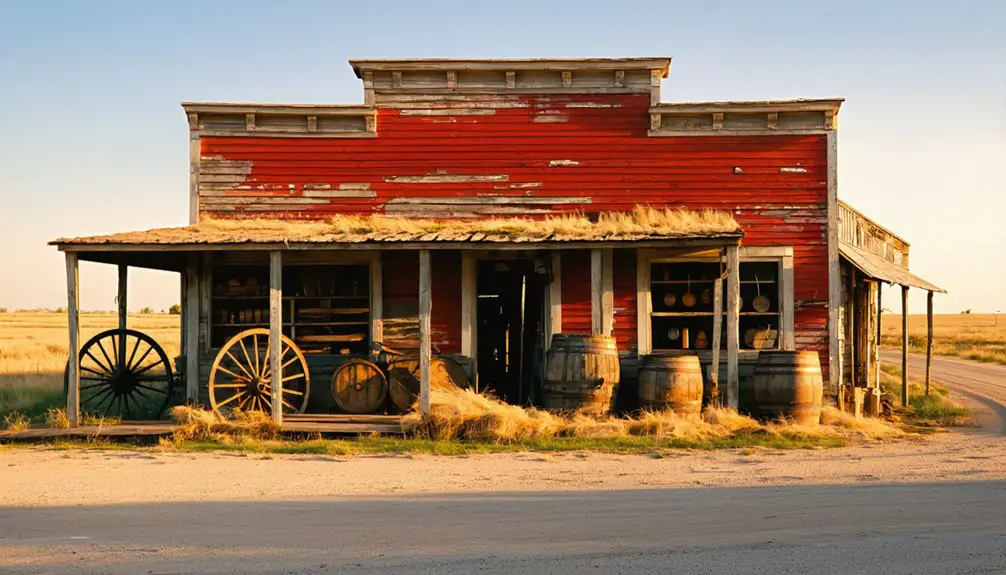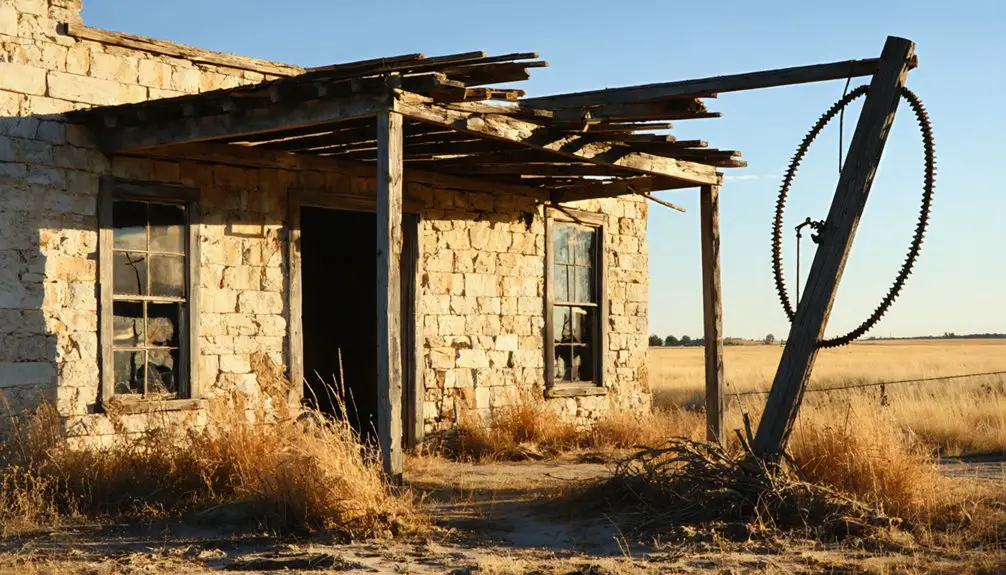You’ll find Sheridan’s ghost town remnants 20 miles southwest of Monument, Kansas, where this wild frontier settlement emerged in 1868 as a Union Pacific Railroad terminus. Within two weeks, 65 businesses sprouted up, serving buffalo hunters and traders while averaging four deadly encounters monthly. The town peaked at 2,000 residents amid brothels, saloons, and raids by Cheyenne Dog Soldiers. The limestone buildings that once housed this lawless community hold countless untold tales of the American West.
Key Takeaways
- Sheridan, Kansas began in 1868 as a booming railroad town with 65 businesses established within just two weeks.
- The town peaked at 2,000 residents during its heyday as a buffalo trading post and railroad terminus.
- Extreme lawlessness plagued the town, with four deadly encounters monthly and numerous saloons operating simultaneously.
- The town’s prosperity was short-lived as railroad expansion continued westward, eventually leading to its abandonment.
- Limestone buildings and ghost stories from its wild frontier days remain as remnants of Sheridan’s brief but vibrant existence.
The Birth of a Railroad Frontier Town
As the Union Pacific Railroad Eastern Division pushed westward in the summer of 1868, Sheridan emerged at a strategic location 20 miles southwest of Monument, Kansas.
Named after General Philip Sheridan, this frontier outpost marked the temporary end of the tracks and served as a crucial gateway to the western territories. You’ll find its location perfectly positioned at the junction of the railroad and a 120-mile wagon route connecting to the Santa Fe Trail at Fort Lyon, Colorado.
Within just two weeks of its founding, 65 businesses had sprung up to serve the growing population. The area later attracted diverse groups of settlers, including English and German homesteaders who helped establish permanent communities in the 1880s.
This surge in railroad history showcased the rapid frontier expansion of the American West, as Sheridan’s strategic position made it an important transfer point for freight, buffalo hunters, and traders heading westward. Like the early automotive industry in America, Sheridan represented a key phase of transportation development in the nation’s history.
Wild West Commerce and Trade
You’ll find Sheridan’s economic heart in its bustling buffalo trade, where hunters and traders used the town as their operational base for exploiting the Great Plains’ wildlife resources.
The town’s strategic position as a railroad terminus made it a natural hub for freight companies and outfitters, who established warehouses along the tracks to supply wagon trains bound for New Mexico Territory. Local residents frequently bartered with buffalo carcasses found abundantly in the surrounding plains. The harsh continental climate brought temperatures ranging from negative thirty degrees to well over 100 degrees Fahrenheit.
Within mere weeks, Sheridan’s commercial district swelled to 65 businesses catering to the needs of merchants, buffalo hunters, and settlers heading west on the 120-mile wagon road to Fort Lyon.
Buffalo Trade Bonanza
The buffalo trade transformed Sheridan and the American West into a bustling hub of commercial activity during the late 1800s. You’d find hunters taking down thousands of buffalo daily with their .50-caliber rifles, leaving carcasses scattered across the plains. Successful hunting teams required multiple specialized roles including hunters, skinners, and cooks to operate efficiently.
The economic impact was staggering, as Eastern markets couldn’t get enough of buffalo products. Under General Sheridan’s strategy, the mass killing of buffalo helped eliminate Native resistance.
When you’re tracking the town’s rise, you’ll notice how the trade created numerous opportunities. Hunters, skinners, and bone collectors flocked to Sheridan, each seeking their fortune.
As buffalo herds dwindled, enterprising folks turned to gathering bones, which they’d sell for fertilizer and bone china. The boom didn’t last forever, but while it did, Sheridan thrived on this lucrative trade that helped fuel America’s westward expansion.
Freight and Outfitting Hub
Sheridan’s strategic position as a Union Pacific Railroad terminus transformed it into an essential freight and outfitting hub by 1868.
You’d find warehouses lining the railroad tracks, where merchandising firms managed vast quantities of goods bound for points west. These establishments handled everything from basic provisions to specialized equipment for wagon trains heading to New Mexico Territory.
The town’s importance as a commercial center was evident in three key operations:
- Large-scale handling of hides, furs, and wool for wholesale trade
- Distribution of outfitting supplies for westbound settlers and merchants
- Management of freight routes connecting eastern markets with frontier destinations
You couldn’t find a better-positioned town for moving goods across the frontier, until the railroad’s westward expansion to Kit Carson changed everything. The arrival of buffalo hunters in 1874 further established the area’s significance in the regional trading network.
Life in the Lawless Frontier
During its brief but turbulent heyday, life in frontier Sheridan epitomized the raw violence of America’s western expansion, with an average of four deadly encounters occurring monthly amid its dusty streets and packed saloons.
You’d find law enforcement struggling to maintain order, with sheriffs facing deadly confrontations while attempting to quell the chaos erupting from the town’s numerous brothels and drinking establishments. The town’s lawlessness reached such extremes that thirty-seven liquor licenses were issued in just two days. The bustling trade center reached a population of two thousand residents at its peak.
While you dealt with internal lawlessness, external threats loomed as Cheyenne Dog Soldiers conducted raids along crucial transportation routes, stealing livestock and disrupting trade.
You’d have witnessed the town’s response through public hangings and militia patrols, though the transient population of buffalo hunters, rail workers, and traders kept Sheridan in a constant state of unrest despite these attempts at establishing order.
Mining Boom and Economic Evolution
As southeastern Kansas’s first underground shaft mine opened near Scammon in 1874, Sheridan’s economic landscape transformed from a frontier trading post into a bustling mining hub.
You’d have witnessed primitive mining techniques evolve from horse-powered hoists to mechanized operations, while the population swelled to 2,000 residents.
Here’s how Sheridan’s mining boom shaped the region:
The mining boom transformed Sheridan from a modest frontier post into a vital economic hub connecting trade across the region.
- Freight companies, merchants, and buffalo traders established thriving businesses, making Sheridan an essential commercial center.
- The railroad’s arrival spurred rapid growth, connecting the town to broader markets.
- Underground mining dominated until 1931, when labor strikes and competition from oil forced a shift to strip mining.
The town’s prosperity wouldn’t last forever – as railroad construction pushed westward, Sheridan’s population dwindled, marking the end of its mining glory days. The community’s decline mirrored other mining settlements that became defunct by the late 1930s or early 1940s.
The Great Migration West

You’ll find Sheridan’s early growth directly tied to the Kansas Pacific Railway‘s westward expansion in 1868, which brought waves of homesteaders seeking fresh starts on the Kansas prairie.
The promise of cheap land through the Homestead Act drew pioneer families who established farms and ranches across Sheridan County’s rolling plains.
Your ancestors might’ve been among those determined settlers who, between 1870-1890, transformed this remote railway stop into a bustling agricultural community.
Railroad Sparks Town Growth
When the railroads expanded westward in the late 1800s, they transformed migration patterns and fostered unprecedented growth in towns along their routes.
Railroad expansion brought revolutionary changes to settlement patterns, with urban migration following the iron rails across the frontier. You’d find thriving communities springing up wherever the tracks were laid, as railways delivered both people and economic opportunities.
The railroad’s impact on town development was profound in three key ways:
- Created essential distribution hubs for agricultural and industrial goods
- Established employment centers through railroad operations and maintenance facilities
- Connected isolated communities to larger markets and migration flows
Towns with strategic railroad connections quickly became magnets for settlers seeking new opportunities.
If you were looking for economic prosperity in the late 19th century, following the railroad’s path often led to success.
Pioneers Seek New Opportunities
The Great Migration marked a transformative period in American history when over six million Black Americans left the agricultural South between 1910 and 1970, seeking refuge from Jim Crow oppression and new economic opportunities in Northern, Midwestern, and Western cities.
Pioneer aspirations drove families to leave behind the devastation of Southern agriculture, where the boll weevil had ravaged cotton crops and economic prospects had dwindled.
You’d find these determined pioneers pursuing better wages in automobile factories, steel mills, and public transit systems. The opportunity landscapes of urban centers promised not just employment, but also education and political freedoms beyond the South’s oppressive constraints.
Despite facing ongoing racial challenges, World War I’s industrial labor shortages and the subsequent economic boom created unprecedented possibilities for Black Americans seeking a fresh start.
Legacy in Stone and Soil
Rich deposits of white Magnesian limestone and fertile black loam soil shaped Sheridan’s enduring physical legacy in Kansas.
You’ll find these natural resources influenced everything from the town’s stone structures to its economic activities, creating a reflection of frontier ingenuity that still dots the landscape today.
The area’s natural bounty supported three key developments:
The region’s abundant resources fueled crucial growth through mining, construction, and farming across the Kansas prairie landscape.
- Mining operations, including the Phil Sheridan and Zella M. mines, built with local stone foundations
- Durable limestone buildings, from warehouses to mills, some visible until recent years
- Agricultural expansion across the rolling prairie, where rich soil supported farming after the buffalo hunting era
Though Sheridan’s boom lasted briefly, its soil fertility continues supporting agriculture, while scattered stone foundations remind you of the town’s frontier ambitions.
Tales From the Prairie’s Past

Life in frontier Sheridan erupted with wild intensity during its brief but dramatic heyday from 1868 to 1870, as this railhead town swelled from nothing to 2,000 residents in mere months.
You’d have witnessed a raw spectacle of frontier life where prairie legends were born – four violent deaths per month and frequent hangings painted a grim portrait of lawlessness.
The ghost stories you’ll hear today spring from those wild days when buffalo hunters, traders, and outlaws mingled in Sheridan’s numerous saloons and brothels.
While hauling freight to Fort Lyon and beyond, wagon masters battled harsh elements and dodged trouble in this untamed outpost.
Within two years, though, you’d have seen the town vanish as quickly as it rose, leaving only memories and crumbling foundations in the Kansas wind.
Frequently Asked Questions
What Happened to the Original Buildings When Residents Moved to Kit Carson?
Like pioneers protecting their treasures, you’d have seen residents carefully dismantling their buildings, preserving every board and historical artifact before loading these building materials onto flatcars bound for Kit Carson.
Were There Any Famous Gunfighters or Outlaws Associated With Sheridan?
You won’t find any documented gunfight legends or outlaw tales tied to this specific settlement. Unlike Dodge City or Wichita, there’s no historical evidence linking famous gunslingers to this location.
What Native American Tribes Inhabited the Area Before Sheridan’s Establishment?
Before 1500, you’d find four major Native tribes dominated this region: the Kansa (Kaw), Osage, Pawnee, and Comanche peoples. Their cultural significance centered around mixed hunting-horticultural practices along river valleys.
How Did Winter Weather Conditions Affect Daily Life in Sheridan?
You’d experience manageable winter survival with minimal snow transportation issues. Brief cold snaps required extra heating and warm clothing, while moderate winds and limited snowfall allowed continued daily activities year-round.
Did Any of the Original Sheridan Families Remain in Kansas?
You won’t find evidence of Sheridan families staying in Kansas. Historical records show they packed up and moved west to Kit Carson, Colorado, when the railroad extended there around 1870.
References
- https://en.wikipedia.org/wiki/Sheridan
- https://fhsuguides.fhsu.edu/kansasheritage/sheridancounty
- http://www.ghosttownsusa.com/sheridan.htm
- https://legendsofkansas.com/sheridan-county-kansas/
- https://sheridanmedia.com/news/96870/some-history-of-sheridans-passenger-trains/
- https://www.legendsofamerica.com/we-mushroomtowns/
- https://www.cottonwoodranchks.com/historical-timeline.html
- https://www.historynet.com/skin-bones-plains-buffalo-trades-flourished/
- https://time.com/6114737/buffalo-bill-cody-wild-west-myth/
- https://centerofthewest.org/2020/11/20/points-west-rough-riding-wild-west/



